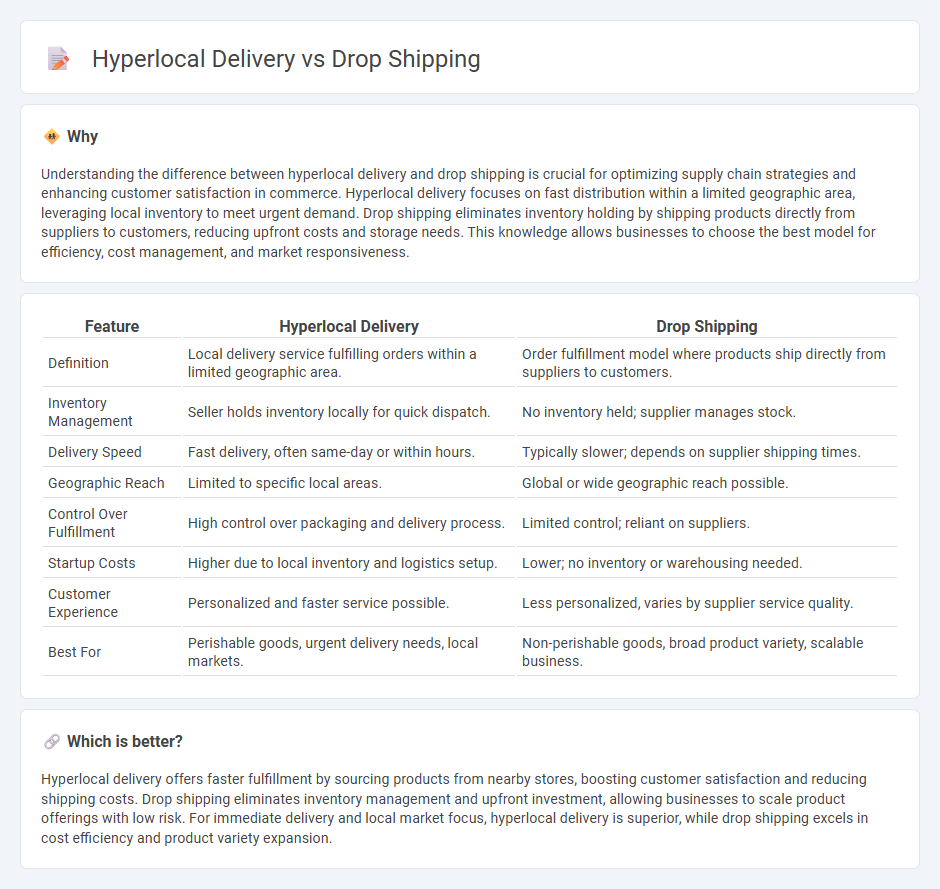
Hyperlocal delivery focuses on fulfilling orders within a specific geographic area, ensuring rapid shipping and enhanced customer satisfaction through local inventory management. Drop shipping eliminates the need for inventory by directly forwarding customer orders to suppliers, allowing businesses to operate with low upfront costs and minimal storage requirements. Explore the key differences and benefits to determine which model best suits your commerce strategy.
Why it is important
Understanding the difference between hyperlocal delivery and drop shipping is crucial for optimizing supply chain strategies and enhancing customer satisfaction in commerce. Hyperlocal delivery focuses on fast distribution within a limited geographic area, leveraging local inventory to meet urgent demand. Drop shipping eliminates inventory holding by shipping products directly from suppliers to customers, reducing upfront costs and storage needs. This knowledge allows businesses to choose the best model for efficiency, cost management, and market responsiveness.
Comparison Table
| Feature | Hyperlocal Delivery | Drop Shipping |
|---|---|---|
| Definition | Local delivery service fulfilling orders within a limited geographic area. | Order fulfillment model where products ship directly from suppliers to customers. |
| Inventory Management | Seller holds inventory locally for quick dispatch. | No inventory held; supplier manages stock. |
| Delivery Speed | Fast delivery, often same-day or within hours. | Typically slower; depends on supplier shipping times. |
| Geographic Reach | Limited to specific local areas. | Global or wide geographic reach possible. |
| Control Over Fulfillment | High control over packaging and delivery process. | Limited control; reliant on suppliers. |
| Startup Costs | Higher due to local inventory and logistics setup. | Lower; no inventory or warehousing needed. |
| Customer Experience | Personalized and faster service possible. | Less personalized, varies by supplier service quality. |
| Best For | Perishable goods, urgent delivery needs, local markets. | Non-perishable goods, broad product variety, scalable business. |
Which is better?
Hyperlocal delivery offers faster fulfillment by sourcing products from nearby stores, boosting customer satisfaction and reducing shipping costs. Drop shipping eliminates inventory management and upfront investment, allowing businesses to scale product offerings with low risk. For immediate delivery and local market focus, hyperlocal delivery is superior, while drop shipping excels in cost efficiency and product variety expansion.
Connection
Hyperlocal delivery and drop shipping intersect through their focus on efficient order fulfillment and customer proximity. Both strategies reduce inventory costs by leveraging local suppliers or third-party vendors to ship products directly to customers. This connection enhances e-commerce scalability while minimizing delivery time and logistical expenses.
Key Terms
Inventory Management
Drop shipping eliminates the need for inventory storage by relying on suppliers to fulfill orders directly to customers, streamlining order management but sacrificing control over stock levels. Hyperlocal delivery requires precise inventory management within localized warehouses or stores, ensuring rapid fulfillment and real-time stock availability for immediate customer demand. Explore how these inventory management strategies impact operational efficiency and customer satisfaction.
Delivery Radius
Drop shipping operates with a vast delivery radius, often nationwide or international, relying on suppliers to ship products directly to customers, minimizing inventory management. Hyperlocal delivery emphasizes a tightly bounded delivery radius, typically within a few kilometers, enabling ultra-fast fulfillment and personalized services tailored to local demand. Explore more about how delivery radius impacts operational efficiency and customer satisfaction in both models.
Supplier Integration
Supplier integration in drop shipping involves seamless coordination with multiple distant suppliers, enabling automated order processing and inventory updates through advanced API connections. Hyperlocal delivery emphasizes close collaboration with local suppliers to ensure rapid fulfillment, real-time stock visibility, and efficient last-mile delivery using integrated POS systems. Explore the nuances of supplier integration to determine the best fulfillment strategy for your business needs.
Source and External Links
Drop shipping - Wikipedia - Drop shipping is a retail business model where the seller accepts customer orders without keeping inventory, instead transferring orders to a supplier who ships directly to the customer, allowing minimal upfront investment but with less control over product quality and shipping.
What Is dropshipping? How does it work in 2025? - Sell on Amazon - Dropshipping is a fulfillment model where entrepreneurs outsource the storing, handling, and shipping of products to third parties, focusing on marketing and sales while the supplier manages inventory and fulfillment.
What is Dropshipping: A Comprehensive Guide for Entrepreneurs - Dropshipping allows a store to sell products without holding inventory by purchasing them from third-party suppliers who ship directly to customers, with profits made on the price difference.
 dowidth.com
dowidth.com